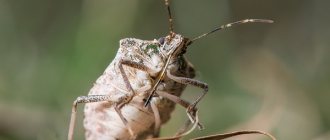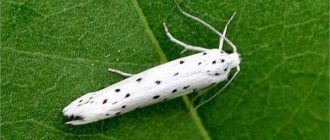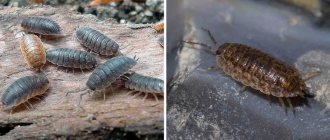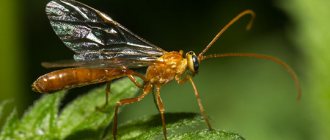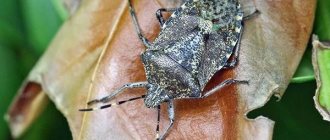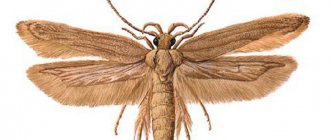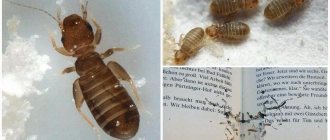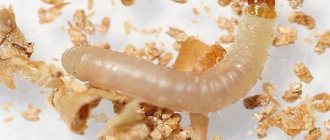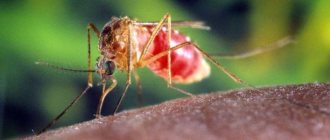Description and characteristics of the insect
People call moths all insects belonging to the order Microlepidoptera.
Adults are similar in appearance to small butterflies, which are mainly nocturnal or crepuscular .
Another feature of the moth is the structure of the jaw apparatus. It is a gnawing type, which allows these insects to easily feed on dense and rough food.
Their powerful jaws help them chew even wood and fruit seeds, and their unpretentiousness in food determines the wide distribution of these pests.
greater damage to plants, tissues and products when it is in the caterpillar stage.
Appearance of a moth
Although there are many types of these insects, they are similar in appearance.
The moth has an inconspicuous appearance, the size is 5-9 mm.
Their size does not exceed 5-9 mm. They fly poorly and are dull in color. There are 2 main types of moths living in houses: clothes moths and furniture moths. The first has a light brown color, and the second is gray, but with a quick inspection it is difficult to identify these differences.
Externally, the caterpillars of these insects and other species of butterflies are no different. They rarely exceed 1.5 mm in length, so they are difficult to notice. The larvae are sedentary, love dark places and eat a lot.
How long does he live?
Before becoming adults, these insects go through the egg and larval stages. The caterpillar lives from 3 to 10 months. At this time, it actively feeds and destroys clothing, furniture, food, and forms a cocoon in which its further development occurs.
After the wings appear, the adult does not live long - only 2-4 weeks (this depends on the type of pest).
expectancy at all stages of moth formation is about a year.
Where does it live?
Depending on the species , the habitat of insects will be different. Food moths lay eggs in food.
Food moths lay eggs in food.
It can be:
- cereals;
- candies;
- vermicelli;
- cookies, etc.
Furniture moths feed on outerwear made from natural woolen fabrics, fur, etc. They often develop in closets and suitcases where sunlight does not penetrate.
Indoor moths can develop anywhere in the house where there are favorable conditions for it, as well as products made from natural fabrics such as cotton, silk, etc.
In addition, these insects can live on different plants (cabbage, potatoes, poplar, chestnut, wormwood) and harm them. They also live in beehives, where they feed on beebread, honey and wax.
In nature, some types of moths feed on the horny formations of animals and birds. They settle in their burrows or nests. There is a species of moth that lives in the horns of buffalos or antelopes, and in the shells of dead turtles.
Species living in rooms
Species of moths that live in houses and spoil clothes and food are called indoor moths. In appearance they differ little from each other. The following types of house moths are distinguished:
Clothes moth
These are butterflies with yellowish wings that have no pattern. Their wingspan is 9 mm. Insects infest woolen fabrics and knitwear. Sometimes clothes moths also damage semi-synthetic materials, but with such feeding, the development of the larvae occurs much more slowly.
Male moths are active and capable of flying quite long distances. Females fly poorly and move by flitting from place to place. Pregnant females hardly move and lead a secretive lifestyle.
Caterpillars are attached to clothing using covers made from their secretions. They eat holes in the tissues that are difficult to repair. Damage is difficult to notice at first glance, since pests do not touch the top layer of the material.
Fur coat
This variety can ruin an expensive natural fur coat in a short time. Butterflies have shiny dark wings with black dots, their wingspan is from 14 to 15 mm. The white larvae look like worms.
The fur moth feeds on clothing made from natural materials. With sharp jaws, like scissors, the caterpillars trim the wool on fur products, grind it and eat it. To get from the feeding site to the nest, they cut winding tunnels. In this way, numerous tracks of trimmed fur are formed on a fur coat or hat.
Furniture
This is a butterfly with inconspicuous wings of a golden hue. Its larvae eat winding tunnels in upholstered furniture. First, they eat the hair on the upholstery of seats and backs, then they crawl to the surface and gnaw the furniture upholstery.
The larvae develop into pupae on the undersides of chairs and sofas. A lot of pupated insects accumulate there. The maturation period of the larvae depends on how complete their nutrition was. On food rich in proteins, caterpillars develop quickly and turn into adult butterflies within a month.
Adults reproduce intensively. Female furniture moths are fertile, their clutches contain up to 200 eggs. They lay them on the surfaces of furniture so that the hatching larvae have food.
Food
This moth is sometimes called granary moth. It looks like furniture, which is why these two types are sometimes confused. Food moths are found in flour, cereals, sugar, and dried fruits that have been stored for too long or incorrectly. Insects are sometimes found in bags of dry cat and dog food. They do not damage fabrics or furniture. Food moths also live in nature, where they feed on nuts and dried fruits of trees. It is common in the steppe and forest-steppe zones.
This insect is up to 8 mm long. A moth sitting with its wings folded is difficult to notice and is often mistaken for a protrusion on the surface. Granary moth caterpillars are light-colored, with a yellowish or pinkish tint. Before turning into pupae, they are sedentary and lead a secretive lifestyle. Before pupation, the caterpillars crawl out of their shelters to the surface and form cocoons.
The development period from eggs to adult butterflies takes one and a half months. Insects develop intensively at a temperature of +25 ºC and at a humidity of 50%. Food moths fly poorly and enter the house along with contaminated food. Mating and laying eggs in insects occurs in the same place where they bred. Products containing food moths are not suitable for consumption. It is better to throw them away immediately so that the moths do not breed in large quantities.
Life cycle of a moth
The moth lays 50-80 eggs per clutch in a dark place, the size of which is no more than 0.5 mm. During their development, a caterpillar appears. On clothing, females choose places near pockets and on collars; They love old rugs or blankets that have not been used for a long time.
Moth eggs go through a long stage of development to the state of an adult.
The caterpillars begin to feed on what the eggs were laid in (fabric, food, etc.). After emerging from the pupa, females soon begin to mate with males and lay eggs. They do this not far from the place where they appeared. After mating and before laying eggs, 5-6 hours pass, and after another 5-6 days the female dies, because fulfilled its purpose - gave birth to offspring.
If we talk about clothes moths, they produce only 1 generation per year, while, for example, cabbage moths can produce up to 5-6 generations in the spring-autumn period.
Are moths dangerous for humans?
Even if the house is perfectly clean and tidy, this will not prevent moths from appearing in the living area. For example, food moths can come from food purchased at the store. This is especially true for cereals, so when you bring them home, you should always check the integrity of the packaging and for the presence of food moth larvae.
Butterflies lay tens and hundreds of eggs, after which larvae soon appear and begin to actively feed on things or food. They are located near the egg laying site and begin the destructive process there.
You can easily notice lumps of cobwebs and empty cocoons after the life of the insect. If such signs are noticed, it is necessary to immediately take urgent measures to eliminate the pest.
Unlike other dangerous insects, this pest does not cause infection, but causes great damage to household life, destroying things, furniture, and many types of food. This type of food is not dangerous to humans, but it does become contaminated, so it is best to throw it away
It is very important to identify moths in a timely manner and protect your home from this dangerous pest.
Pest varieties
The most common:
- Food. There are several types of it. They differ from each other in the products in which they prefer to reproduce . They have some external differences in the color of the wings: the grain moth is off-white, the flour moth has a black-brown pattern, and the granary moth is black-orange. The length of the wings in all individuals does not exceed 10 mm. The larvae are transparent white, at 6 weeks of age they reach 1.5-2 mm and begin to pupate.
- Clothes. Smaller, reaching no more than 3 mm in length. There is no pattern on her wings; they are light brown. The larvae are yellowish in color with a brown head.
- Furniture. Similar to the previous species, but the size of adults reaches 8 mm. The coloring is slightly darker and the larvae are white. It is distinguished by a well-developed jaw apparatus, providing the necessary pressure for eating dense food. Has a large intestine and stomach.
- Cabbage. The gray color makes it inconspicuous. There is a light pattern on the wings. This color allows for good camouflage. These insects are larger in size than house moths . The duration of maturation of the larvae in the egg is 72 hours. The caterpillars are 12 mm long and green in color. First they live in the lower part of the leaf, and then crawl to its upper part, where they create a cocoon. During the maturation period, 4 moults occur.
- Poplar. It has an inconspicuous appearance, its length is up to 7 mm. There is fringe on the hind wings. It enters the house through open windows. The maturation of the larvae lasts 2-3 weeks, they have a yellowish tint.
- Potato. They are distinguished by a grayish-brown tint. The wings have a pattern of brownish-yellow stripes and spots, the edges indicated by dark lines. The fringe on the hind wings larger than the wings themselves. The length of insects is 10-16 mm. The larva reaches 10-12 mm, it is almost completely transparent. Its color depends on its diet: the one that feeds on leaves becomes green, and the one that feeds on tubers becomes pale gray.
- Wax. Quite large, reaching 20 mm, while males are smaller than females. At rest, females fold their wings and males spread them. The period of egg development is 10 days. As the caterpillar matures, it molts 10 times.
The food moth is an insect for which your kitchen can become its habitat.
Development and reproduction
The caterpillar or house moth larva goes through several stages of molting before it turns into a pupa. The time after which pupation occurs depends on external conditions and the type of butterfly. For example, food moth larvae develop faster than clothes moth caterpillars, since their diet is much richer. They are able to go through the entire development path in 4-5 weeks. Moreover, the higher the temperature, the faster they will grow. Under the same conditions, clothes moth caterpillars will need 2-3 months to develop.
For pupation, the larvae choose dark and hard-to-reach places; only some types of food moths move out of the closets into the light. The pupae range in size from 6 to 9 mm. Their outer coverings become darker in color than those of caterpillars and harden. Under the protection of this shell, the entire next stage of transformation of the pupa into a butterfly will take place.
After 1-2 weeks, an inconspicuous gray butterfly will appear from a case hanging on the wall of the closet. Her life will be short - about 2-3 weeks. During this time, she must have time to mate with her sexual partner, find food suitable for feeding the larvae, and leave offspring.
Moth eggs are so small that they are difficult to see with the naked eye. They do not exceed 0.5 mm in length. Typically, eggs are white and oval in shape. Under favorable conditions, the larvae hatch within a week. A newborn caterpillar has a body length of about 1 mm and a transparent skin. As it grows, it increases in size and becomes darker in color.
How does it reproduce
To fight these insects, you need to know how moths reproduce .
This process includes steps such as:
- egg;
- a caterpillar that turns into a chrysalis;
- adult.
Only male moths fly. The female crawls around in search of a secluded place in which she lays eggs.
Moth caterpillars eat a wide variety of things and foods.
The rate of egg hatching directly depends on the ambient temperature:
- if it is less than 13°C, the ripening period is up to 37 days;
- at 33°C – 7 days.
Types of moth larvae
To figure out what a moth larva looks like, you need to find out what type it belongs to. Experts identify several types of these pests:
- Clothes - eats felt, wool, felt and other fabrics;
- Furniture – feeds on upholstery of upholstered furniture;
- Carpet - can greatly damage carpets, paths, rugs;
- Fur coat - prefers fur;
- Kitchen - found in grains (barley, rye or wheat), often spoils dried fruits, seeds, berries, nuts and seeds.
The main difference between these individuals is precisely their preferred habitat - the clothes moth larva will not settle in cereals, grain or flour, and the kitchen caterpillar will never gnaw through clothing or textiles.
In appearance, these larvae are almost identical - they are small white or yellowish caterpillars with a brown head and clearly visible gnawing jaws. Most moth larvae are worm-like and have 6 pairs of legs. Photos will help you verify this.
The larvae can also be recognized by the structure of their “house”. Thus, the caterpillars of fur coat, carpet and clothes moths make a small cocoon from the remains of damaged textiles and a silk-like substance and put it on themselves. In this form, they are even able to move short distances. As for the larvae of furniture and kitchen moths, they create tunnels from food scraps, silk and excrement.
Moths are an invisible but insidious enemy. In a very short time, your fur coat may become unwearable.
Having recognized the pupa by its appearance, you will be able to choose effective means to destroy these pests.
Reasons for appearance
To effectively combat moths, you need to find the source and reasons for its entry into the apartment .
The main reasons for the appearance of moths:
- Flew in through an open window on its own. If there is no protective net on it, then this insect can fly into the house and take root in it. Using a mosquito net will eliminate such troubles.
- Brought into the house along with things. These could be woolen or knitted clothes that you took from your grandmother. It is not necessary that these are adult pests: their larvae, which are difficult to notice, are sufficient. To prevent this from happening, things should be well ventilated and left in the sun for several hours before bringing them into the house.
- Came with old furniture. The larvae can be found in the upholstery of old sofas. They look like small white cocoons. Almost all old furniture is contaminated, so if there is a need to bring it into the house, you must first treat the fabric with special means.
- Introduced by domestic animals . Larvae may be on their fur, so you should periodically wash the animals with special shampoos that help get rid of any parasites.
- It came with cereals that were improperly stored in a warehouse, or with dried fruits and mushrooms purchased at the market.
Most often, moths enter an apartment along with new things that contain fur and wool.
Moth control products
After cleaning, you can begin treating the room in various ways. Below you will find detailed instructions on how to deal with moths.
- To destroy indoor moths, you can purchase ready-made products - an aerosol, a fumigator or a section.
- All surfaces of furniture, cabinets, and rooms are treated with an aerosol. After use, do not enter the room for several hours, then be sure to ventilate it. Not suitable for use in the kitchen.
- Fumigators can be used throughout the apartment, as they do not emit substances harmful to humans. The downside is that the coverage is small, so it is advisable to install several devices. Completely gets rid of pests in a few days.
- Sections are almost ineffective in controlling moths, but are excellent for repelling females.
- Natural remedies are best for killing kitchen moths. Thoroughly treat all surfaces with baking soda solution. Wash the cracks of the kitchen set with water and vinegar diluted in it. Place the remaining food in hermetically sealed jars.
- Check plumbing fixtures for serviceability and repair any leaks.
- Place allspice grains, bay leaves or chestnuts in the cupboards.
- It is advisable to cover the ventilation holes with gauze.
Read here: How to clean stainless steel: TOP 20 simplest solutions for removing dirt and grease
How to fight insects
It doesn’t matter which way the moth got into the apartment. It is necessary to begin fighting it immediately after identifying the first adults or larvae. The sooner you start doing this, the faster you will be able to get rid of the pest.
Chemicals
Previously, tablets made from a mixture of naphthalene and camphor were often used, but the danger is that their vapors in high concentrations are harmful to humans .
Now there are many safe means:
- "Antimol." Available in tablets. It is enough to put 3-4 pieces in the closet. The tablets are valid for 21-28 days, then they are thrown away. The product is used to repel, not kill, moths.
- "Dezmol" is a drug similar to the previous one. Available in tablets.
- "Molemore." Validity is up to 6 months, but no more than 2 records can be used in one room. The drug repels, but does not destroy, insects.
- “Suprozol” is a drug in the form of an aerosol. Spraying in places where moths accumulate helps to effectively destroy adults and larvae.
- “Supromit” is a liquid product used to treat furniture surfaces. Its validity period is several months.
- "Moskitol" is a product in the form of plates. They are laid out in places that they want to protect from the penetration of moths.
- "Raid Antimol" is a popular drug. Available in the form of plates, gel or spray. The method of use depends on the release form.
- "Raptor". When sprayed onto clothing, it leaves no traces on it and has a pleasant smell.
Antimol is a reliable means of killing moths.
Special sections effectively repel moths. They have a pleasant aroma and can be safely used even to protect children's things. Mount them at the top of the cabinet. 1 section is capable of protecting a space of up to 0.5 m³. At the same time, in a room with an area of up to 15 m³, no more than 2 pieces can be used. The section is valid for 4-6 months.
Destruction of larvae
To fight them you will have to make efforts, because... larvae hide in the most inaccessible places. Clothes moths are easier to remove than food moths. To do this, take things outside and shake them out well, then leave them in the sun, and if possible, wash them at 60°C. After this, they are treated with moth repellents, and the cabinets are also treated.
If food moths are detected, you must urgently get rid of all contaminated food products. Adults are destroyed using aerosols. The shelves on which the products are located are treated with liquid agents or sprays (they must be stored in sealed containers).
Using aerosols, moth larvae are destroyed.
What folk remedies exist
Many people are afraid of the toxicity of chemicals, so they prefer proven traditional methods.
It must be remembered that most of these products do not destroy moths, but simply repel them.
Commonly used folk remedies:
- Orange peel. Place it in places where moths can lay eggs. It repels adult insects. The peel should be changed at least once a month.
- Laundry soap. They put it in the closet and also wash furniture with it. The downside is that the smell gets absorbed into the clothes.
- Lavender, wild rosemary, tobacco, chamomile, fir. It is enough to change bouquets of these herbs once every six months.
- Fir or lavender oil. Place an open bottle in the closet or soak cotton wool in it.
- Geranium. It is enough to have 1 such plant in a room, and its smell will effectively repel pests. It is better to place the flower on the window so that insects cannot get into the house.
- Rosemary, garlic, cloves. They are placed in jars with cereals.
- Vinegar. They are used to treat the surfaces of bedside tables, cabinets, and storage rooms.
- Temperature. Moths are afraid of both heat and cold. Clothes should be washed at 60°C, exposed to the sun at a temperature of about 30°C, or exposed to frost – 10°C.
Folk remedies can help fight moths.
Covers for fur coats against moths: an effective measure of protection
Covers will help protect clothes - an excellent anti-moth remedy for fur coats. They are needed for seasonal clothing made of drape, mixed fabrics and fur , which moths especially love.
Coats, fur coats, jackets, suits and dresses are stored in covers; they are suitable for transportation and protect clothes from dust.
Products can be purchased at hardware stores (for example, the Raptor brand); the best options for storing valuable mink and sable coats are offered in specialized fur salons.
The best covers are made from modern synthetic materials that do not interfere with normal air exchange. They are hermetically fastened with a zipper or Velcro tape.
Products may be impregnated with repellent drugs. Such covers are very effective , but anti-moth impregnations are toxic and not suitable for allergy sufferers .
Soaked products should be protected from children and pets; clothes packed for storage should be placed in the closet so that they do not touch other things. It is advisable to allocate a separate section for it. Impregnated anti-moth covers remain effective for up to 12 months .
An alternative could be a product made from thick cotton or thin plastic. You can make a convenient case yourself.
The style is simple : a rectangle with a sewn bottom and a zipper along the entire length. The size depends on the length of the product; the coat or fur coat should fit into the case freely, without tucking.
Hand-sewn covers must be washed every year after the end of the storage season. They can be treated from the inside with aerosol preparations that repel moths. At home, it is better to use odorless preparations. They irrigate not only the covers, but also the walls of the wardrobe.
Watch a video on how to properly prepare a fur coat for storage:
Prevention
It is always easier to prevent moths from appearing than to fight them, so you must adhere to the following rules:
- Before bringing food, items or old furniture into your home, carefully check them for the presence of larvae and adult moths.
- If you find contaminated food, throw it away.
- Wash items from second-hand stores at 60°C;
- Ventilate your kitchen cabinets periodically. If you have an ultraviolet lamp, it can be used instead of sunlight.
- Place a clove of garlic in the container with cereal.
- Have geraniums in your house.
- Place anti-moth tablets in the cabinets.
Use aromatic oils in cabinets and cabinets with food, which not only repel moths , but also smell pleasant. Compliance with the described rules and recommendations will help protect the house from the appearance of moths, and if this dangerous pest penetrates it, then effectively fight it.
Previous
MothWhat moth larvae look like and how to get rid of them
Next
MothUseful tips and recommendations on ways to destroy cabbage moths
How to protect a fur coat from moths?
Fur products are threatened by leather beetles and fur moths. But even ordinary clothes are partial to fur coats, hats and collars .
REFERENCE! The larvae gnaw the pile, leaving noticeable bald spots on fur coats. Most often, the sleeves, front and back, as well as the area at the collar are affected.
Insects are especially partial to short-haired fur: astrakhan fur, astrakhan fur, and mink. Moths can also damage the lining, leaving holes in it . Having noticed the slightest signs of pests, you need to urgently take measures to save your favorite fur coat.
A moth has eaten my fur coat, what should I do? The product is removed from the wardrobe and placed on wide hangers. It is best to hang the fur coat in a cool room : on a glassed-in loggia or veranda. First, the fur is cleaned with a brush from the outside and inside . Then the fur coat must be thoroughly shaken , removing moth larvae and eggs.
The fur coat is generously sprayed with repellent designed to destroy moth larvae.
For home use, products that are unscented or have a neutral lavender scent are suitable. Choose drugs with minimal toxicity.
It is better to carry out work with gloves, protecting the respiratory tract with a gauze bandage. Not only the top of the fur coat is processed, but also the lining and the inside of the sleeves . Carefully spray the area under the collar or hood, cuffs, decorative elements, and folds.
ADVICE! It is convenient to process a very wide fur coat in a horizontal position, laid out on a table or ironing board.
Do not use repellents that have expired; they are practically useless. You cannot use several products from different manufacturers at the same time ; many drugs do not combine with each other, forming harmful fumes.
After treatment, the fur coat is left for half an hour and then placed in a sealed case with anti-mole impregnation . It is better to leave the product outdoors for 1-2 days, and then put it in a separate section of the closet. Before placing the fur coat in the wardrobe, you need to treat the walls and shelves with repellents and ventilate thoroughly.
You should not place wool products stored without covers next to your fur coat. It is better to remove felt boots, yarn supplies and other items that attract moths from the section where fur is stored.
It is very difficult to completely eradicate clothes moths. However, timely preventive measures, hygiene and attention to your own wardrobe will help keep your clothes intact. It’s important to remember that preventing pests is easier than making them leave your home forever.
NOTE! There is a wax moth that lives in beehives. A tincture based on its larvae has many medicinal properties.
What do moth larvae eat?
The diet of a moth larva is determined by its species. In nature, larvae feed on animal hair, bird feathers, vegetables, fruits, berries, nuts, and grains. A food moth larva living in an apartment can eat:
- flour;
- cereals;
- bran;
- cereals;
- legumes;
- pasta;
- cookie;
- nuts and seeds;
- dried fruits;
- candies and chocolate.
As for other species, that is, the larvae of clothes, fur, carpet and furniture moths, they feed on:
- natural fabrics (cotton, wool, linen, silk);
- fur;
- synthetic fabrics, if they contain natural fibers.
Nutrition
Even though the larva is tiny and eats very little, a large colony of parasites can cause serious damage to things.
What does a moth eat?
There are many types of such pests and each of them has its own “specialization”. There are fruit, potato and even poplar moths, one of the species loves cabbage, an insect is known that eats mushrooms - all of them can only get into a person’s house by accident, that is, they cannot cause harm in an apartment.
However, there is also a food type of moth in the apartment; it is also called kitchen moth. It feeds on flour, and its diet also includes various grains, so you can often see a butterfly flying out of a container with it. This variety can also spoil some other product (seeds, nuts, dried fruits, etc.).
When you see a moth that feeds on semolina, you don’t have to worry about your fur coat, just like you do about other clothes. But since any product that this insect feeds on is high in calories, the food species multiplies very quickly, so the kitchen may be subject to an entire invasion. You can fight it successfully and quickly, but it is better to get rid of it in the early stages so as not to finish eating some product after the pest.
There are several other species of this insect living in the apartment, from which it is most necessary to protect all property in the house, since their habitat is the closet. Where any product, if there is such a moth, is in danger, since any of them feeds on clothing.
Upholstery fabric, carpet, felt boots, in some cases even wallpaper or hair from a natural wig, books can also be used. Moreover, a narrow specialization of the pest is also present here: there is a clothes moth (which loves cotton items, cotton). Even if the clothes are partially made from synthetics, this is not a hindrance, the only difference is that any non-natural fiber is not digested in the pest’s stomach, so it develops and multiplies more slowly.
This variety is combined into one type with furniture. There are also different varieties of fur pests, from the name it is clear what they eat, each of them is natural fur, including any fur coat, fur collar on a coat, etc. As evidenced by numerous photos and videos of damaged items.
Moreover, now scientists claim that the moth that has infested eats not just clothes, including fur coats, but feeds on fatty deposits, skin particles, and sweat on them. Any such product has more calories and is more convenient to eat than the fur itself, therefore, if there is a choice, the pest butterfly will fly to lay eggs first not in the closet where clothes (the same fur coat) are stored, but where there are pollution.
How do moths eat clothes?
First of all, you need to know that clothes, including a fur coat, are not eaten by the well-known butterfly, but by a larva that looks like an ordinary caterpillar (it can be seen in the photo). The butterfly itself is an adult at the last stage of development; it is needed for reproduction; it must do this quickly, since it can live from 8 days to several weeks.
Moreover, the butterfly does not eat anything; even if it wants to, its stomach is still unable to digest fur, cotton and any other food. That is, only the larva, which emerges from an egg laid by a flying moth directly on the food source, causes harm. When at least one egg is laid, we can assume that there is a moth in the closet, since in just a few days it will leave it and immediately begin to feed.
Each larva causes a little harm, but since they do not live alone, the consequence of their desire to eat looks unpleasant, as a large number of photos on the Internet will confirm. The damage can often be hidden, but the larva that is eating the fur coat must be destroyed first or it will soon have to be thrown out.
What types of moths are there?
Fur moth
The fur moth is an individual that has shiny dark yellow wings, with dark specks on the wings. The lower layer of the wings differs in color from the outer ones: they are light gray. The wingspan ranges from fourteen to fifteen millimeters. The fur moth prefers to feed on clothing made from natural materials.
Clothes moth
The clothes moth is larger in size than the fur moth; its wingspan is up to twenty-two millimeters. She also has two pairs of wings, which are purple at the very base, turning yellow towards the middle, with a small brown spot at the very top. The clothes moth larva is covered with a small white fluff and is similar in appearance to the coat moth larva.
Furniture moth
Furniture moth - a representative of this species has shiny silver-yellow wings, the head is dark yellow, and the base of the wings has a brown tint. This variety of keratophages has a significant difference from all other species and thanks to this it was declared a separate genus. This difference is the absence of oral tentacles.
